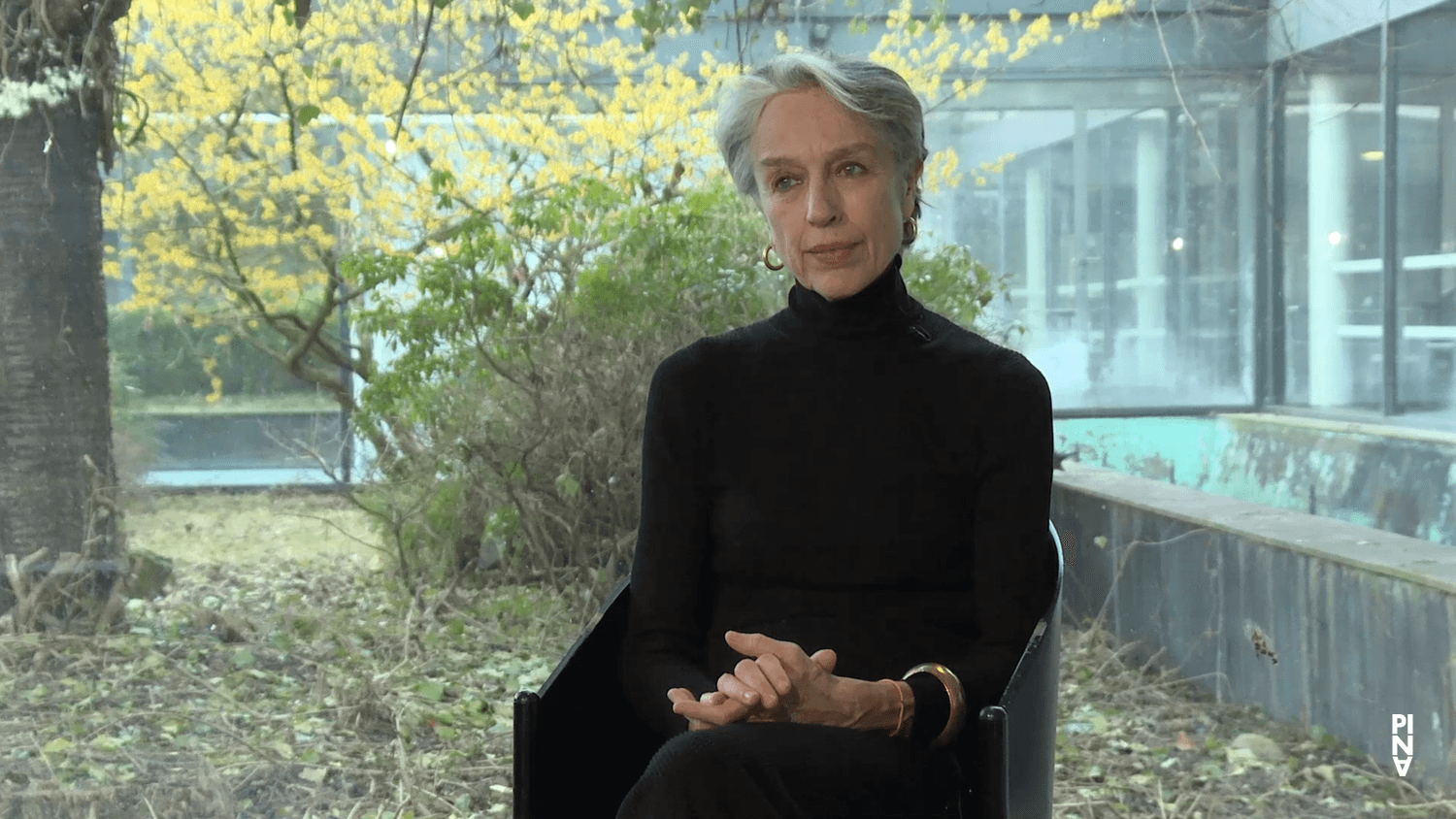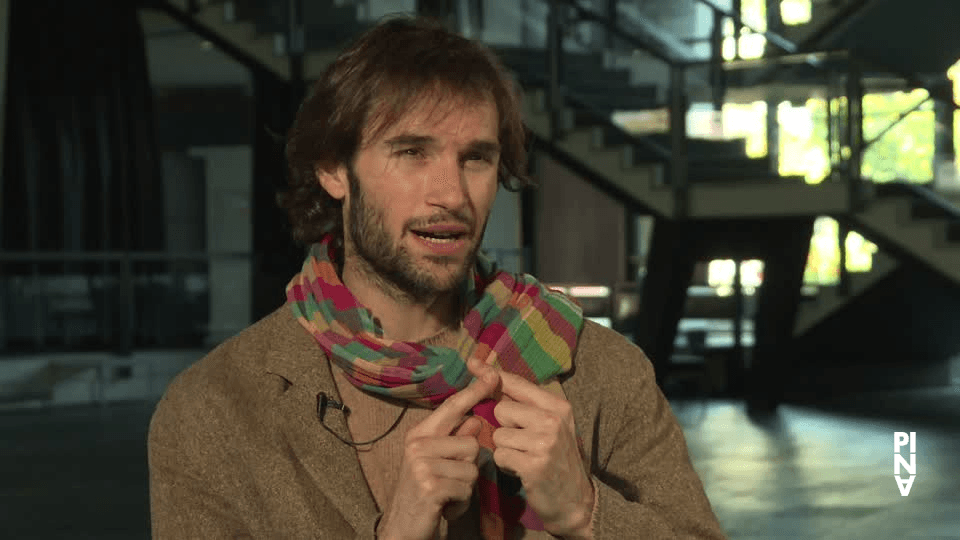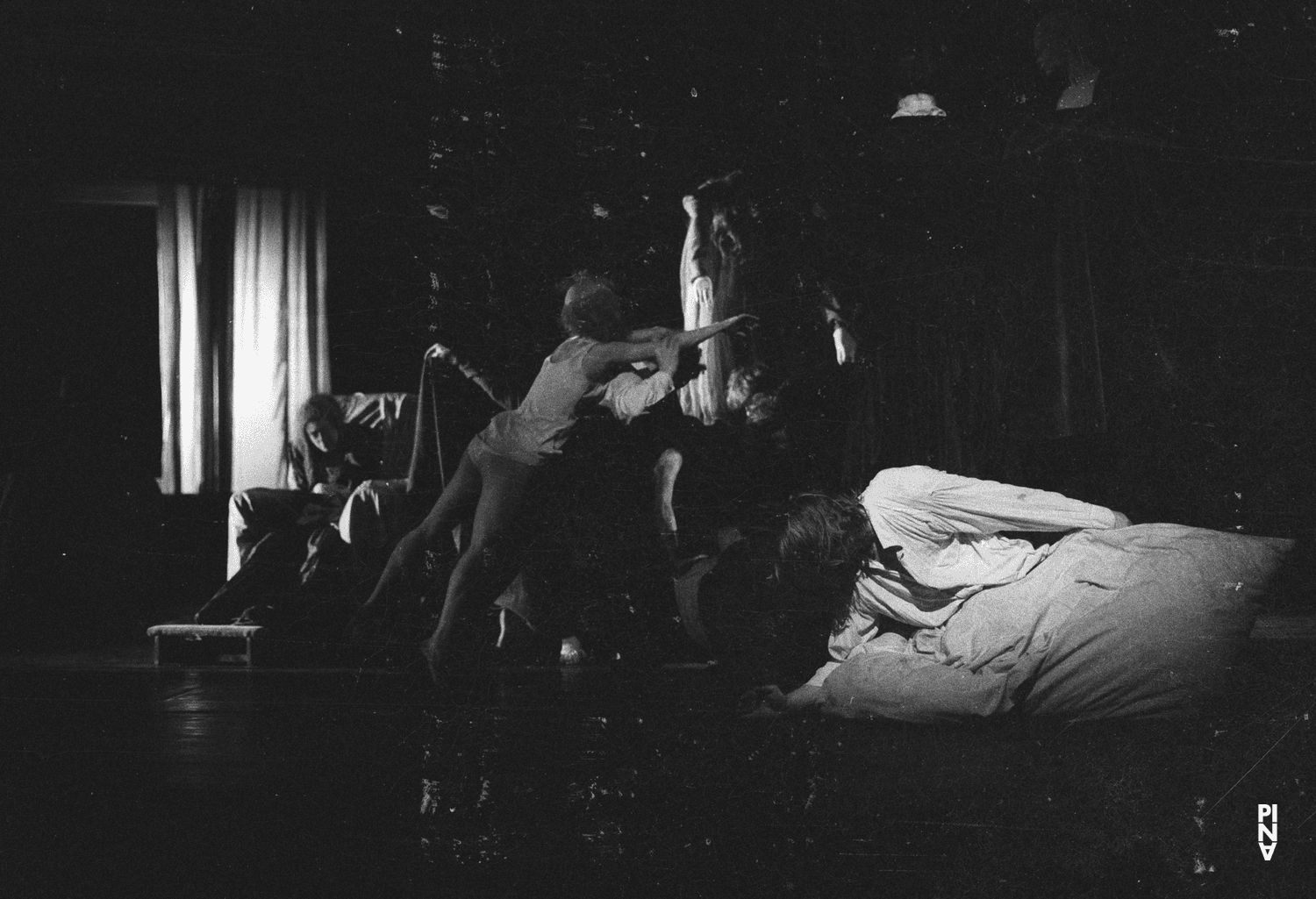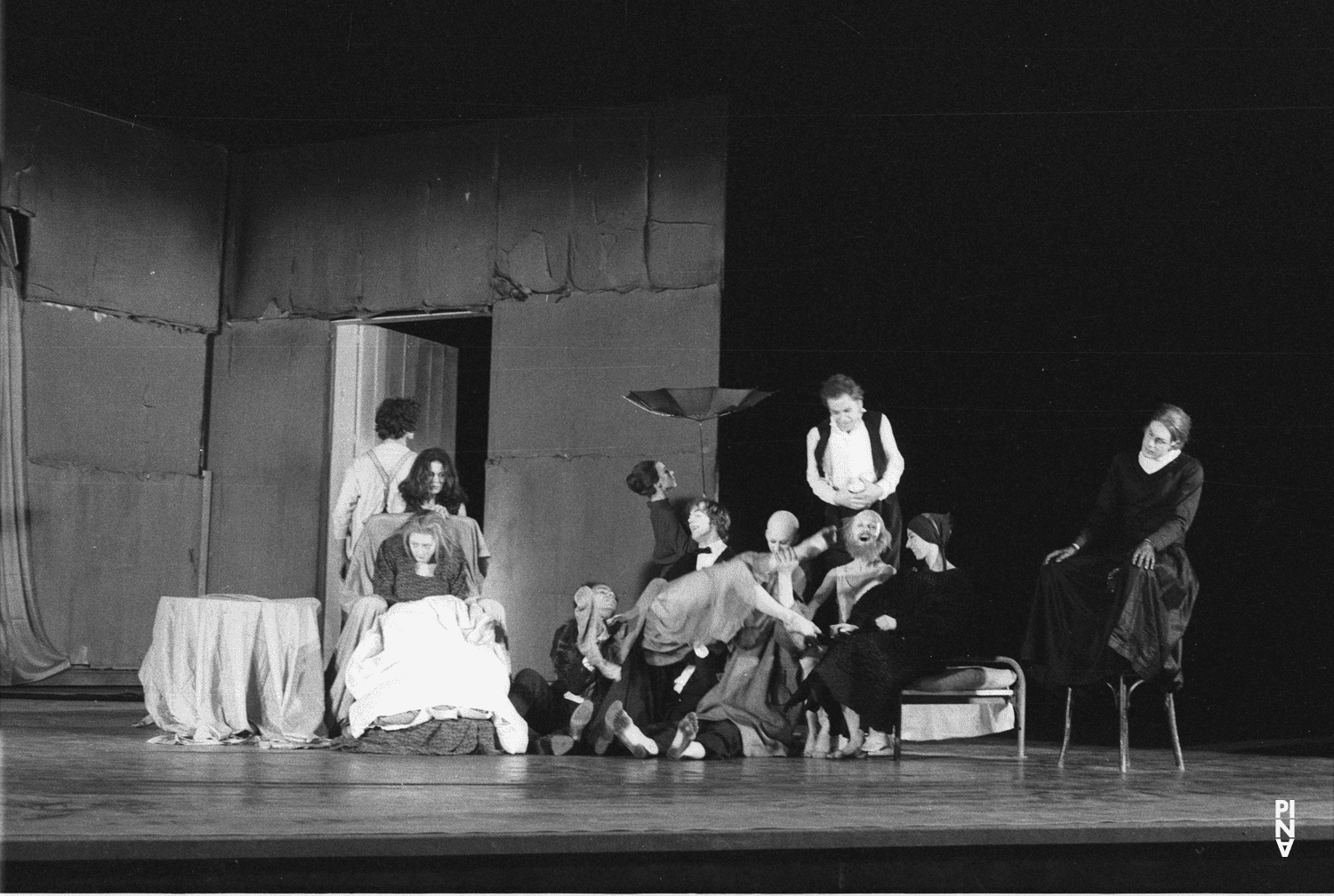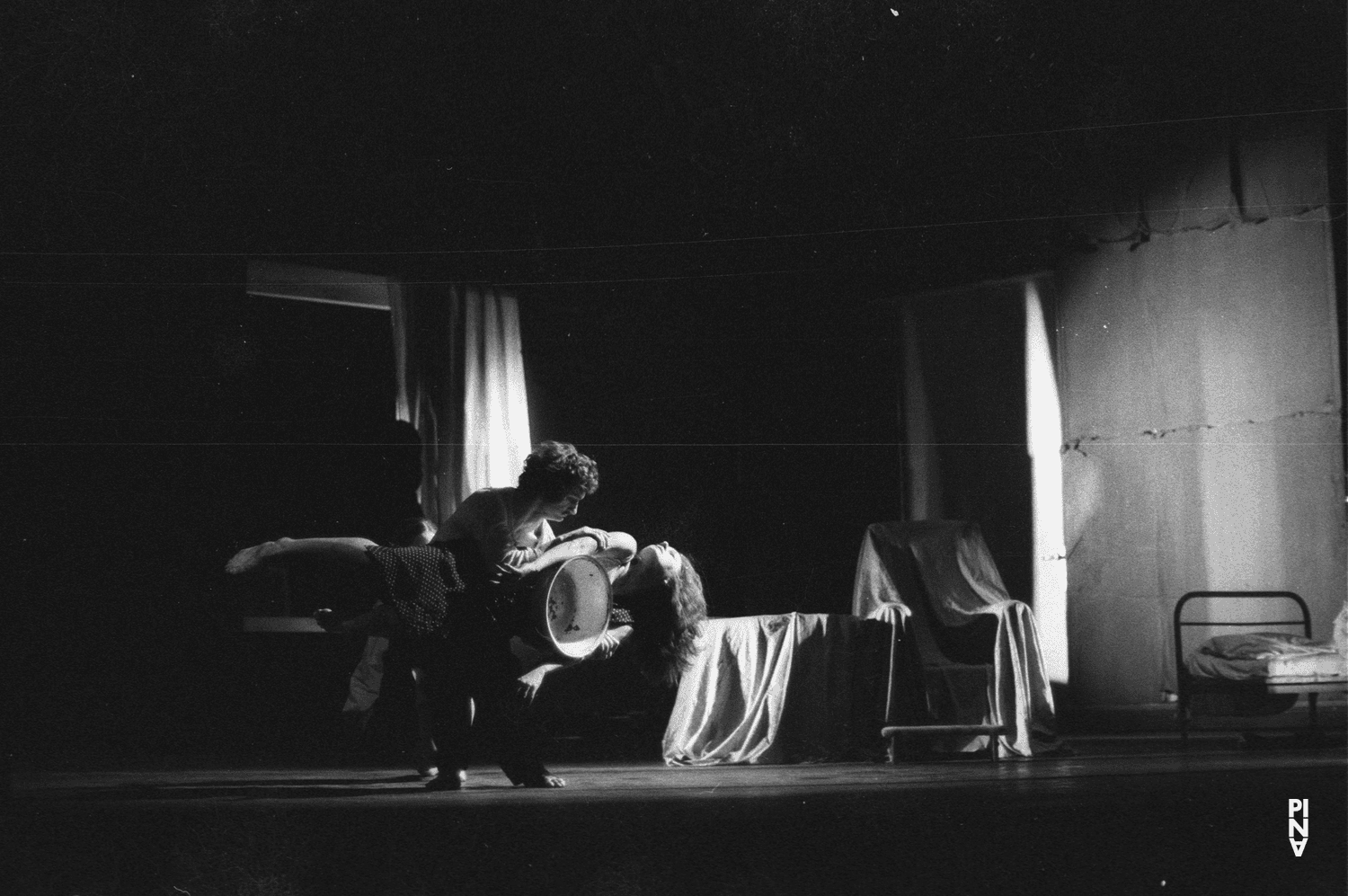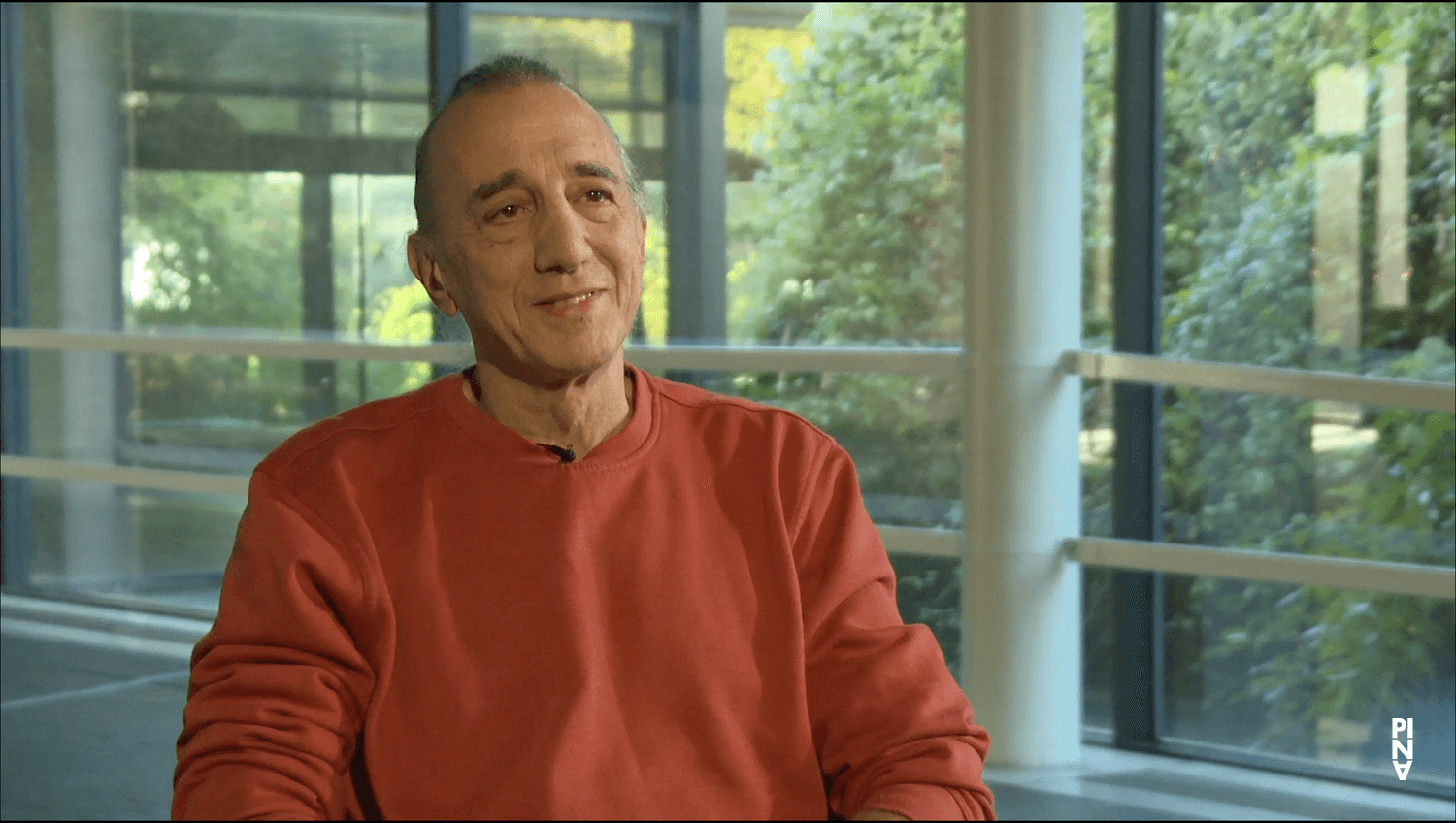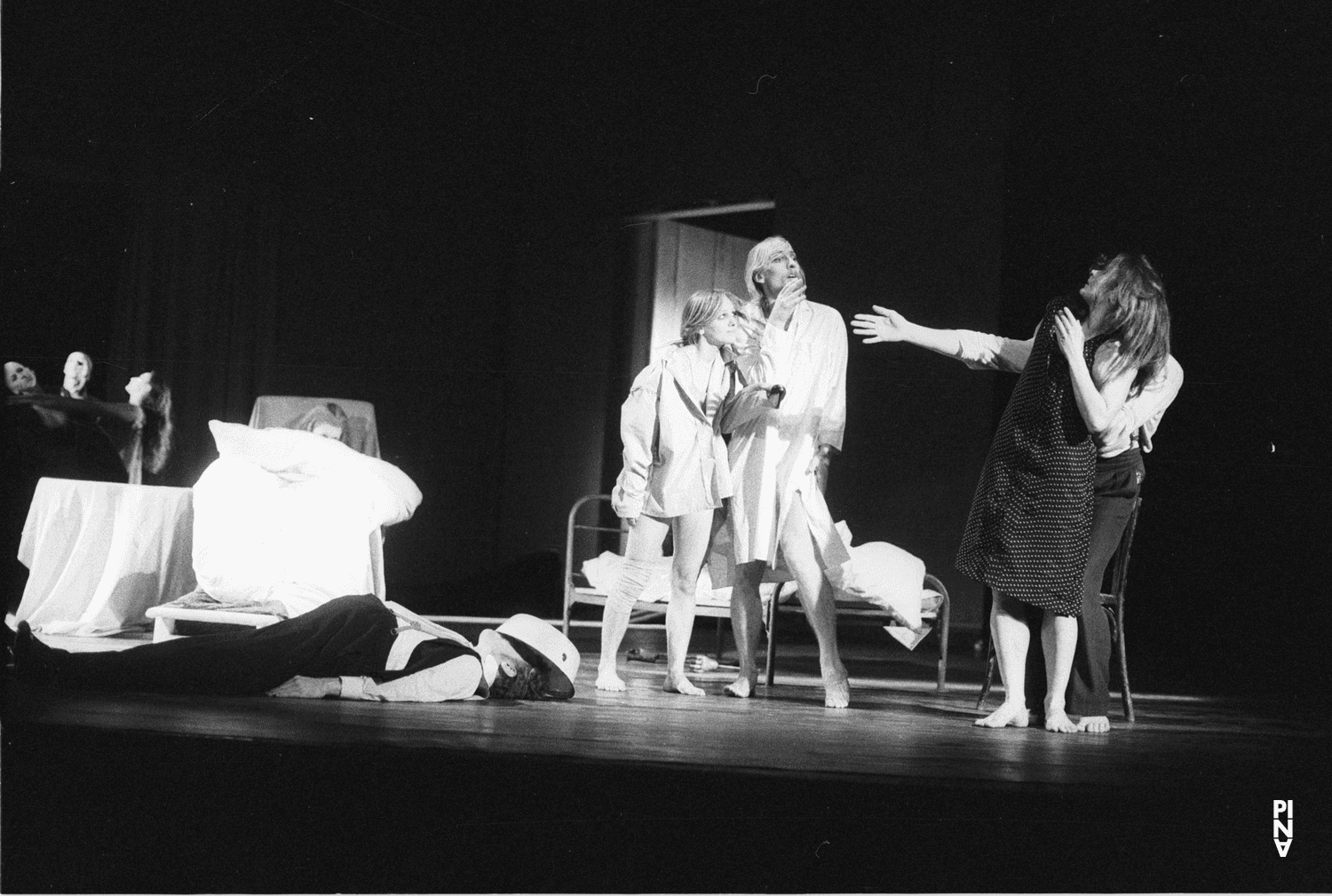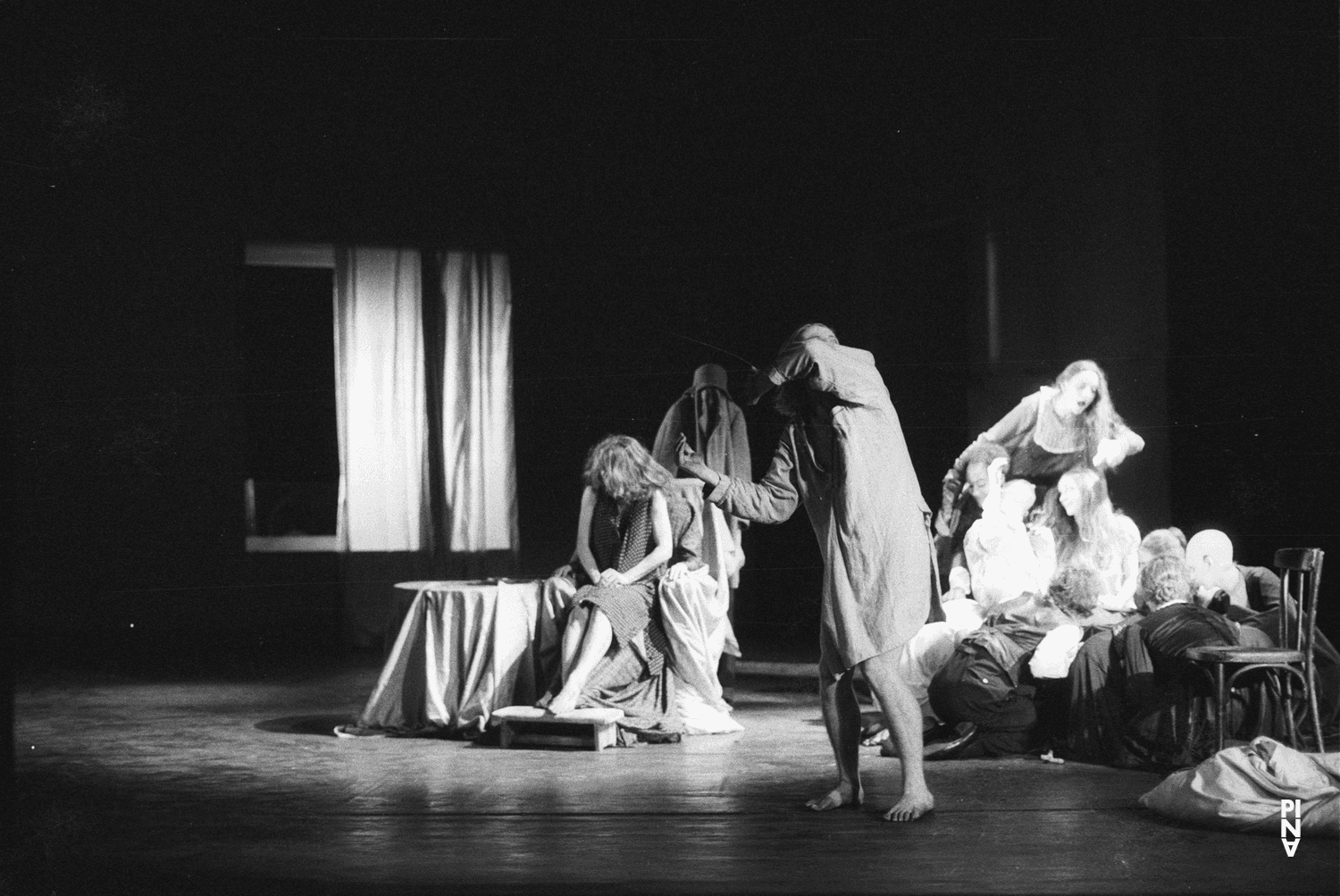Interview mit Finola Cronin, 18.8.2018 (2/2)
In diesem zweiten Teil ihres biografischen Interviews stellt Finola Cronin Zusammenhänge zwischen gesellschaftlichen und politischen Ereignissen und dem, was in den Stücken zu sehen ist, her. Sie spricht ausführlich über ihre Erfahrungen mit Café Müller und ihre Arbeit in der von Meryl Tankard geschaffenen Rolle. Das Stück Ahnen wird unter dem Gesichtspunkt der nationalen Provenienz und der Suche nach Ausdrucksformen kommentiert. Als Theaterwissenschaftlerin ist ihr Interview reich an Kontextualisierungsdetails.
Interview in englischer Originalsprache
| Interviewte Person | Finola Cronin |
| Interviewer:in | Ricardo Viviani |
| Kamera | Sala Seddiki |
Permalink:
https://archives.pinabausch.org/id/20180818_83_0001
Inhaltsübersicht
Kapitel 1.1
Verbindung zum WeltgeschehenRicardo Viviani:
We could probably look at some of the social-political events that were happening in the world and how that informed the work. We have first 1986.
Finola Cronin:
Yes, 1986 and Viktor, that was the first piece that I worked with in creation, with Pina. This was the co-production with Teatro Argentina in Rome. So we went first off to Rome, and observed and… everyday the questions. That's all been documented and recorded, I am aware, you know: ‘What did you see in Rome today?’ And so on. Of course we come back to Wuppertal after three weeks or so and then Chernobyl happens at that period. That is right, isn’t it? That was 1986? I have a vivid memory of us being in Lyon on tour, and Pina was there and she was really quite aufgeregt [upset]. She was worried, clearly worried, and I remember her saying, ‘You have to be so careful about the milk. We have also to be careful about what we eat and what we drink.’ And I think she had, of course, concerns about her child as well, about Rolf Salomon, at the time, and what was going to happen to the next generation, in fact, with this contamination. Of course, now we realise that we weren’t being given the full truth about these things at the time. The technology wasn’t what it is today, and therefore there was a lot of vagueness still, about where exactly these clouds had gone, and where the rain would fall, and whether, at what extent, it was contaminated. Now we would have a very different visual mapping of all of this. That was certainly a critical aspect – in a very personal way, something that also affected… that was visible to see how much it really affected her.
Kapitel 1.2
1980 in Berlin und der Kalte KriegFinola Cronin:
I think, I suppose, beside that, in terms of the social, socio-political, I have another vivid memory of us being in East Berlin; I think we performed at the Berliner Ensemble Theater, Deutsches Theater. And I remember – I was watching; I wasn’t in that performance – and the moment where the dancers come out and say the words for their country, the public stood up and applauded, at this moment, because they, arguably, they received this scene as a symbol of inclusivity, a symbol of diversity, of ability to travel, so poignantly the people watching those dancers and performers, from lots of different countries really didn’t have the… weren’t eligible; they weren’t allowed to travel to those countries, so there was quite a tension already in the public, with such disclosure and revelation on stage. These were things that, in fact, we all appreciated. We all had a sense this would be a concern, I would argue, for all of us in the company. As Pina said, that’s why she’s choosing the dancers because of all of body and soul, and intellect and psychology and emotion and so on. And so there’s a sensitivity from all of us about these issues, about politics, about social issues, and so on. But when you really saw it played out in an instance like that, it really has a different impact entirely – I felt anyway, certainly on me it did have a very deep impact about the way in which her work operates, and the power it can actually have, in terms of the relationship with the audience. So it’s subtle. It’s not, as you would say, ‘in your face’ theatre. It is very subtle but it accretes; it builds throughout, the way in which that piece 1980 works, the way in which the performers are introduced, the whole story about the ancestors, about the family, Jan’s story and so on, at the outset, childhood, all of these ideas. They are, if you like, they’re universal and emotional connections that we have as human beings, and that begins to build up, and build up, and then the Reihe [sequence] in the second part where each performer is quasi introduced, and then finally the country, the nationality, the culture. It all builds to this really very powerful, actually political statement, you could say. That’s the way I see it now: that this is what this is about. It’s about freedom. It’s about issues to do with travel in that time as well.
Kapitel 1.3
Nelken und UmweltFinola Cronin:
Another example is Nelken, of course, where that is much more politically visible, through the passport bit and so on, but of course then the counter is comedy. Again, she’s never lecturing in her work at all. She’s never waging a finger. It’s always that process that she brings her public with her, with her performers, with the performance itself, and its dramaturgy, and on the way it builds and it becomes quite clear what really she is talking about. And of course in Nelken as well the ecology is very clear as well, in terms of the destruction of the stage set, of the flowers and so on, at the end.
We could go on.
Kapitel 1.4
FeminismusRicardo Viviani:
The issue of being called a feminist, already earlier in her work. What are your thoughts on that?
Finola Cronin:
I think her position… The more I read, the more I realise that lots of other women who were writing and talking about patriarchy, you know, were also resisting the label of feminist, because of course it closes something off. And she herself, Pina, said this. I think she belongs to a group of both artists and intellectuals and writers and theorists who are interested in patriarchy and the effects of patriarchy – that they refuse to be labelled in this way. Just to go back to the political aspect, Pina clearly also didn’t want her work to be seen as political work either.
Finola Cronin:
She did confide in me once, she said ‘My work is political, you know that.’ And the occasion was, we were on tour with Café Müller in Edinburgh and I was asked, as English speaker, to go and give a number of interviews. She was happy that I do that, but she did say, ‘Now Finola, be careful with the politics,’ not quite like that; I am paraphrasing because she wouldn’t say ‘be careful’, but she’d say, ‘you know, the politics.’ I was brought up in a country where there was a war going on, with Northern Ireland, and as part of our education in Ireland, we’re all very politically engaged anyway, because of our colonial past, and so on. So it’s something that’s very close to us; we are very well educated about colonialism, post-colonialism – even before I went to university at post-graduate level to study that. I would have been very… Pina would know I was always aware politically of what was going on. But she was clearly saying, ‘You know I really don’t want you to take this position vis-a-vis my work.’ Of course I wouldn’t. Now, nachhinein [in retrospect], and in a more theoretical way, I think we can see – through the work itself, not through her personal beliefs as such; we’re talking about what is revealed through the work, clearly through the work, and her concerns, and the concerns of her performers… The artist is part of the world and the work in which he or she lives. It’s a question of how to think about those things slightly differently, and to present it in such a way that causes people to question, to think, to look again and so on. And clearly this is what Pina’s work was doing, always, whether it was about issues to do with gender, like in Blaubart or Kontakthof and so on, relationships between men and women, and then as you say later, issues to do with more socio-political, and then also ecological, the planet, and so on. She was very much part of, let’s say, the topical current thinking, and changed with that – in my view, I should say (laughs), in my opinion.
Kapitel 1.6
Rezeption in GroßbritannienFinola Cronin:
That marked, just to say – I think the company was in London in 1984, and I am not sure when they presented Sacre in Edinburgh, but it didn’t create, I think, such major event. I don’t remember reading that it did. But certainly, when she presented 1980 – and was it Kontakthof? – in Sadler’s Wells in London, as we know – and that has also been well documented – the British really weren’t sure of what they thought about it. But I think that when we went, it must have been 1991, and then subsequent to that it took off, this relationship with Tanztheater and Pina and Sadler’s Wells, and that connection.
Kapitel 2.1
Finola Cronin und Café MüllerRicardo Viviani:
I would like to go in depth into Café Müller, possibly also just some events, how things happened, when one thing led to the other. Learning, casting... Casting: she first asked you to look at Nazareth’s, at Meryl’s role. Do you have an idea, why she was... How was this casting issue?
Finola Cronin:
Yes. I mean it’s true in fact lots of people could have played it. It has a red wig. (laughs) At that time my hair was brown also. I think, possibly when I came here the conversations I would have had with Pina would be about looking at some of Meryl’s roles, some of which needed to be reprised, and some which Nazareth had taken over, but Nazareth was leaving the company. So there was a gap, so I think that it was as simple as that. So I looked at lots of videos and I watched Nazareth, I think, perform it a few times. I can’t remember where, now, I watched that. But I did watch lots of videos of Meryl, and in fact of course choreographically it is quite simple. It’s to do really with the space, how you come in the back door, and so on and so on. I think at that time I might have expected I would get something of a storyline, or a narrative. But I never got this. So it was never discussed, and of course that was kind of, anyway, how Pina worked. But I suppose I had felt, ‘Well I am going into a piece that clearly has some kind of narrative. There’s lots of relationships. It is very sort of narrow, small cast. Clearly everybody has very distinct role.’ But there was no information, no information on a narrative forthcoming. I never knew who she was. So of course in a way that just exemplified Pina’s way of working. First of all, you looked at what was done, because of course the meaning was in where you moved, how you moved, when you moved. That’s where it was all coming from and it wasn’t about fulfilling any kind of narrative as such, or there was no character description as such. I did feel a little, literally, in the dark, very much trying to get the same sound as… She would say ‘Listen to the way the rhythm, of the little tapping…’ because it was these sort of pinkish red shoes – pink I think actually more –, and the turquoise dress, the wig, and the big coat, and then really to be on the balls of your feet, tippy toes, and the rhythm of that walking. I remember she did say one time, ‘You’re coming in, and with you the light comes on in the piece.’ She enters first, of course, and moves along the wall, leans back and then suddenly there’s a moving through the revolving doors upstage, and then the light gradually then enters the stage as well, as you sweep down the stage, and then go off, and then Malou comes in, and so on.
Kapitel 2.2
Der Mantel – Angst vor dem letzten MomentFinola Cronin:
Always I felt a little mysterious; there was always a bit of discussion with me afterwards about, ‘Did I tap there?’ and ‘She wasn’t sure she heard this there.’ Because of course she was onstage; she wasn’t watching. I think sometimes she might have watched the video afterwards to see if it was all working. I suppose – it was a huge challenge. It was such a privilege, of course, to be onstage with her but it was also a huge challenge because I still felt very much like a new member of the company, and I was absolutely terrified at the end. I used to dread what happened at the end. At the end you had to go downstage, and you had to push, take the wig off – you’d have released the pins and the wig earlier – and you put the wig on (gestures putting it on someone else), and then you put the coat on her, or was the coat first? The coat first, and then the wig, (gestures putting them on someone else) and at the same time Pina was making still these little movements that she had to make. And I would think, ‘I am going to miss her, I am going to miss her head, I am going to just… (demonstrates missing), and oh gosh! And how hard to pull it down on her head. And she is taller than me – how hard to pull it down on her head, and how to make sure the coat stays on and doesn’t come off immediately because she’s moving her shoulders.’ Oh the stress! (laughs) The stress of that one thing used to terrify me, really terrify me.
Kapitel 2.3
Ein geschützter OrtFinola Cronin:
But altogether there’s a number of things about that, that whole time, about working with Café Müller. It was like a sanctuary. It was like going into a sort of very sacred place. This might sound a little over the top. I mean this in a very… in the way that the stage – as you know, and so many people would talk about it – as a holy kind of a place. There’s lots and lots of theatre makers who talk about that. But of course it is. It is a very special place. And I think always for every production, and every performance that’s a very powerful… I experience a very powerful – how would I say? – position of the performer vis-a-vis the stage space itself, as this kind of space that is very sacred, very precious. It needs to be minded, and we are careful with that space, and with ourselves in that space, and with each other. And I think in Café Müller this was more accentuated. One of the things was that Pina would herself rehearse, on her own on the stage, and I would sometimes see her and we might go in and warm up, and still would be doing some rehearsal, but she might have started quite early. I am sure other performers, other colleagues, have spoken about that. That really impressed me. I would watch her and she was doing everything full out. So this business of marking with something, that, really, I took to heart, and realised, ‘I can understand this now,’ – that you never mark; you always do full out, as full as you can, you know. Whereas, as we know, in lots of dance companies everything is marked and then is done full out in performance. So certainly she was doing this full out, and then when it came to… it was all very quiet, and it was also out of bounds to the company. Company members couldn’t be backstage during Café Müller. That’s what I mean as well by the sacredness of the space. So nobody else was allowed backstage. As I was saying to you I think yesterday, in other performances people came and looked and walked away again, might go to the canteen if they had a Pause or something, and come back. So Café Müller is obviously a short enough piece but everybody stayed backstage all the time. They had a place that they were. So Malou was in a certain place, Dominique was in a certain place, Jan was, I was, and so on. Pina was onstage all of the time, from the beginning. But there was a sense we were isolated. We were, like, in a little isolated space and nobody would come into that space for the duration of that performance.
Kapitel 2.4
VorbereitungFinola Cronin:
I don’t even know if I can describe what that felt like. But it did add to this sense of it being a very special performance always. Then there was even, what I remember, a ritual about the Spucken [jinx], the Toi-toi-toi [‘break a leg’], at the beginning: who went were, and to whom, and in what order. So I arrived into this piece of work, where already these rituals, and preparation for the performance, had become set; so they were set offstage, or onstage of course, and offstage, backstage. So that was quite extraordinary.
And I’m not saying that doesn’t happen…For example I always had my own rituals, for every performance. There was something; you checked your Requisiten [props], and this (demonstrates). Then I’d often stand in the same place and I would then move to my next place backstage so I was ready for an entrance and so on. But I might have done that, I might be aware that one or two others had also got such rituals, but often because there were so many people performing you didn’t really understand that everybody had their own rituals. Those rituals may not have been visible. But because we were so few in Café Müller and because those – what I understood were – rituals had become very much part of the whole performance of Café Müller, they were very much in place. So that was a learning as well, if you like.
Kapitel 2.5
Roter FadenRicardo Viviani:
Now, having been given no storyline and being into the movement, did you create one for yourself or did the actions – for you – become also, as a performer, the pathway into it.
Finola Cronin:
Yes, I think so. I don’t remember that I needed then to make up stories. The woman in the red wig has various connections in the work, with Dominique, and observes; she minds very carefully what’s going on with Malou, but she doesn’t enter into that. She doesn’t ever touch Malou, or come very close, but she’s all the time watching. And there is no connection with Pina – until the very end, with that figure, direct connection. But there is a connection then with Dominique, the kisses, and then there is a connection particularly at the end with Jan. That woman with the red wig, she’s hovering; she’s kind of somebody who’s hovering around, watching, observing, wants to move in and help but she’s not able to – for whatever reason. So she’s a little bit helpless because of that I think, as well. But I think, more than that, I didn’t give myself any great… There’s definitely a huge connection with Malou. A kind of caring and sort of worry with Malou, certainly – that I felt anyway; that this was part of this wanting to help and support. But that opportunity never arises.
Kapitel 2.6
Die Begegnung von Jan und MerylRicardo Viviani:
But then comes this very mysterious… Comes Jan again, but then as a different person, with the glasses. At the very end. Does that make a difference for the red wig person?
Finola Cronin:
I think, yes, of course, because he comes in on his tippy toes, so this is an aural connection. And there’s a little tiny smile. I think it is in one of the photos. A little smirk: she’s kind of happy. (shows some of the movement) Somebody around is maybe in her wavelength; (laughs) that’s what it is, and that’s as much. It is very subtle really, but there is a kind of sense of ‘Oh you know yeah.’ And then of course she follows him off at the end.
Kapitel 3.1
Besondere BühneRicardo Viviani:
There were some tours where the space was completely other, and I am thinking about Greece.
Can you describe what was done there?
Finola Cronin:
I didn’t perform there, but I certainly went out front to watch that, but again, given the size of the Herodius Atticus, my memory is that I actually didn’t have a very clear view because of this huge big – (gestures a semicircle) as we know – auditorium, this amphitheatre, so I think I had this kind of a view (shows a diagonal) and there were these prospect walls and so on. That’s what I remember. There were some prospect side walls put up to designate the frame of the space of Café Müller within this enormous stage. That’s what I remember. But I don’t remember having a very clear view of what was happening, despite that, but that’s because of the angle I was sitting at.
Kapitel 3.2
Rezeption in MoskauRicardo Viviani:
There was possibly one of your last tours, going to Moscow, performing Café Müller, and the reviews were... They just couldn’t make any sense out of that. As a performer you don’t get much of that.
Finola Cronin:
Not always, no, there was just so much. In fact, I suppose, the business of Tanztheater was so enormous, and it was definitely run at a different level, and we were so busy; my sense would have been, we were so busy.
But just back to different location, you know we performed in Munich at the ITI – International Theater Institut – also. And that was, as far as I remember, also… We didn’t have the proper walls and the whole set design, but maybe that is something that needs to be researched.
Kapitel 3.3
Wände aus PlexiglasRicardo Viviani:
At some point, Peter Pabst created Plexiglas walls for the sides as well, and later as they performed with live orchestra this was used, in the Triennale, last year or the year before, in Nîmes with live orchestra. Peter Pabst said that the beginning of the idea of these Plexiglas walls, which are necessary for the reaction: working against the wall, was at Herodes Atticus.
Finola Cronin:
Subsequent to that we did perform in Munich, before the season began, and we were in Munich at the International Theater Institut, big international Treffen [get-together] and that wasn’t on a stage; that was in some room. That’s what I mean, so that might be worth… I really can’t recollect exactly what the space was like, but as far as I know it was not the original set. So that might be another time when the prospect walls were used.
Kapitel 3.4
Den Doppelabend tanzenRicardo Viviani:
We have Café and then performing Sacre as well, which is completely different. How was that for the dancer?
Finola Cronin:
I think in the early days, when I was really coming to terms with all the movements in Café Müller, and in general with the whole technique and positioning of the body and all that was required, I found it very hard to go from this demi-pointe into this deep plié that you need for the Sacre. You know, it’s an incredible thing the way the body works, because in fact the older I got, the easier it became, (laughs) not the opposite. So it was less problematic later. I was just stronger, a stronger dancer. My body was stronger and better able to manage it. And sometimes you would feel, ‘Oh yeah, it would be nice now not to have to do Sacre,’ and sometimes it was really great to do Sacre, you felt, because it was such a different kind of release in fact. It was lovely to get into your bare feet, get into the turf.
Kapitel 3.5
Osteuropa-Tournee von 1987Ricardo Viviani:
There’s one more tour that I’d like to talk about. 1988 there was also a tour of Gera, eastern DDR, and then Poland, former Yugoslavia, Czechoslovakia…
Finola Cronin:
I mean, of course it was about poverty in many instances, you know; there was a kind of poverty of spirit, and a poverty of goods. It was like our first tour to what was then the Soviet Union, you know. In a way a bit of a challenge for us – I felt for me anyway – to keep our bodies fit for the long hours of dancing. I think we had biscuits in our bag, butter, and all sorts of things, toilet paper, you know; we were told to bring everything with us. So it was that kind of feeling, and I have to say in ‘87 there was no sense of an insurrection that I remember. It looked like it was all there to stay. Although we did have… Where was that? I think it was in Poland. We took a tour and there we were in Wrocław, Breslau. We took a tour anyway, and we had a wonderful tour guide. And you could feel from her description of what was happening, you could feel this sort of national thing going on, but of course they had already the Solidarity thing happening a little bit. But there wasn’t the sense that that was all going to collapse. But in East Germany? I don’t remember that we had any sense that things would change – until two years later, you know. It did happen very quickly really.
We went to parties, and we were being followed a little bit by the Stasi everywhere. (laughs) They were tough tours because, again, we weren’t used to, if you like, [not having] the things we might have had around us here in Wuppertal, in other countries in the western world on tour, so it was a bit tough in that way.
Kapitel 3.6
Kälte in RusslandFinola Cronin:
I may be right, I may be wrong: one of the tours to Moscow… We did two, that I partook in, to the Soviet Union, and one finished a little bit before that explosion at the White House in Moscow, which was within our view from our hotel room. All of that Yeltsin thing was about to take off. One of the tours we took – and I am sure my colleagues can probably remember it better; I haven’t actually thought about this for a while –, we actually ate in the theatre. They actually had the food provided for us in the theatre. Because there was uncertainty about what would happen with our evening meal. So there were definitely shortages. I mean Moscow was, absolutely, at that time really depressing. I mean people were living with so little. They were standing already then on the sides of the roads with fruit and vegetables from their gardens. It was very, very tough.
I’m remembering now, our first trip to Moscow was in a January, so it was very cold, and the next time was October, September or October, and it was also very cold. But because the heating wouldn’t come on until a certain time in the state institutions, there was no heating in the theatre. (laughs) We were actually rehearsing in our coats, this kind of thing. Kontakthof and Sacre I think.
We know now that these things also happened and that actually the way in which the world works: the western world takes so much for itself, and has enough money to buy oil, and so on, and so on. It’s a big complicated world story really.
Kapitel 3.7
Café Müller und das RepertoireRicardo Viviani:
It is a very unusual piece in the whole repertoire; Café Müller is a chamber piece if you will. What are the similarities and differences, between Café Müller and the rest of the repertoire?
Finola Cronin:
It’s interesting that you take that perspective: how does it fit in, how does it not fit in. I mean, I suppose for me, one piece I have huge regrets I never saw was Danzón, which was made just as I left. I got here one Sunday and it had just played early, because on Sunday they played early, and my flight arrived in late. And I remember Pina saying ‘Oh, it’s a shame you haven’t seen this.’ And I really felt I’d loved to have seen that. I suppose in my mind, rightly or wrongly – I know it is not such a small piece but of course she is in it – I don’t see Café Müller as an anomaly, I suppose that’s what I am saying. Because also, when you think earlier days she was making Cantatas, Zweite Frühling, Fritz and all of these other pieces that just didn’t happen to become part of the repertoire, if you like, because she changed so much I suppose, her own perspective on work and dance and so on. So I don’t see it as an anomaly. I never thought of it like that.
Finola Cronin:
Ahnen, (laughs) oh what to say about Ahnen? Raimund Hoghe got some beautiful text from Leonardo da Vinci about the bees. There’s a lovely piece of text he found about the bees, and the wings buzzing, in all sort of stuff, and that’s in the second half, pretty early on the second half of the piece. There was a lovely little solo, which finishes – I have some things to say –, and it finishes by me crouching down on the floor, and Lutz comes in and jumps on my back. You might have seen that image. I am wearing this gorgeous lamé dress in pink and gold, doing a very English thing about stereotype, you know, archetype English about the bees, how the bees bzzzzz, and chatting away doing the usual thing, then I get down on the floor and he comes in and he just jumps on my back. So there are images of that, and it’s not always me whose back is jumped on, but when it was reprised, it was Cristiana Morganti, perhaps, doing that role. That was in the second half. In the first half the one where I am wearing this sort of Tartan scarf across here, this was a question that was about, ‘show us a dance from your country.’ So there is a kind of interesting view about Irish dance, a little bit like Bournonville technique in ballet: the arms are not much used. It’s all really legs. Now you’re probably familiar with Riverdance, where they all move so fast and it becomes this big chorus, but this was before Riverdance, and it was this… There’s a lot competition, and competitive Irish Dance, and it’s all over the world. It’s absolutely huge in America with Irish-Americans. There are probably about 20,000 students of Irish Dance and competitors, between Ireland, England and the United States. It's huge business in fact – which also fuels the whole Riverdance thing, so it’s become very commercialised. So my joke was to wear this sort of sash here, and I got lots of keys, because when they go into these competitions they always wear medals, so the medals bounce up and down and the arms are like this (shows) and the feet are doing all of this stuff, you know. (laughs) So this was my attempt at this. And the idea was as well, that because the back is so vertically held that you look like you’re going to expire, because you’re holding your breath all the time because there is no movement of the torso whatsoever, at the end of this moment I crash over and two guys come in with a stretcher, take me off the stage. (laughs) So it’s kind of one of those in-jokes that I really enjoyed. I don’t know really if anybody else understood.
Finola Cronin:
Yes, that’s what that picture is about. It was quite short. I just did a little bit of Irish dance, the very little bit I know. And the dress that I’m wearing, the skirt, is a sort of dropped waist, and very tight, so there isn’t any possibility to move, really. (laughs)
Finola Cronin:
Making fun of this idea of what had happened and what continues to happen with competitive Irish Dance. Except that in the meantime I know more about it now. I am not quite as cynical, and there are some magnificent dancers, a lot of whom I know very well and really admire. Also Riverdance in fact changed all that because they began to work very differently with the steps, where the virtuosity became much more about not competition and just virtuosity, but it had a different kind of a narrative. It opened up ideas about culture, perhaps. But it’s still a commodification of culture through the dancing body. So it’s also a little bit problematic, as we know.
Kapitel 5.1
StereotypeRicardo Viviani:
OK, let us get into the problematics of stereotypes. Having so many nations and talking about your nations, or… Would that become, for the people, for the different dancers, a problem, being stereotyped into different roles or images, or…?
In general: ‘this is the happy ’, ‘this the...’
Finola Cronin:
That’s interesting that you bring that up. That’s clearly one of the ways in which I viewed a major difference between the work with Pina and the work with Vivienne, for example. Vivienne was in a smaller setup, so as a performer one was required to play happy, sad, tragic, melodramatic and all of this, if you like, the palette; you could test your palette of performance capacity and capability differently. Clearly when you come into a big company like this there will be people who will do tragic brilliantly, who have… You’re not so much type-cast, but I think what happens is one understands that if there’s going to be somebody around who will embody a certain idea, emotion, character, psychology, just by how they look and how they move, critically, then it wouldn’t make sense that somebody who doesn’t do that should try and do it, on stage – not that they shouldn’t try and do it in rehearsal, yes, but that role might be differently moulded and shaped. And those who have that particular…, who are given through their appearance, through their movement quality, who are given certain characteristics to portray certain emotional things, would probably do that more powerfully. That’s not to say that that would be very cut and dry, because there’s always going to be a counter position as well, to try something where the tragic will not look so good, so it becomes complicated; you might try it out on somebody who actually is the comic usually, and so on. I suppose people would come to mind, amongst my colleagues then, who really were so magnificent in terms of their movement quality and how they made meaning with their bodies… I think would be clear for me that that would be something that I could never do as well as they could do, so why would I? It’s just that her palette, Pina’s palette, of course was so wide. She had all of these nuances, and colours to choose from, all these different tones. Ultimately it’s the piece that matters. It’s beyond one’s own ambition. I think we all completely understood that – I shouldn’t speak for everybody; from my own perspective, and from discussions with colleagues, that was never something that was an issue. I don’t ever remember that there was an issue about casting, second casting or anything like that, if it was about learning work. And if it was about making new work, well then that was the work you made; you created those roles, and they were worked on, and kept or not.
Kapitel 5.2
Die Suche nach ErneuerungRicardo Viviani:
Do you agree with this: that there was really also, movement-wise, a strong search there for breaking moulds, finding new...
Finola Cronin:
Auf der Suche [in search], always looking. In fact I think artists, great artists always look; they are always looking for new ways and new things. That’s the condition of the artist, I think, rightly or wrongly; it’s a never-ending search. Of course they’re so conscious. They don’t want to repeat themselves, they don’t… The not wanting to repeat is also simply because they have, through that work, brought themselves somewhere else. There is that building, accumulation, accretion of work that has happened before, that better informs. When I was here, Pina was in her mid-forties, when I began to work with her. She already had this substantial body of work. And that she herself then, if you like, moved in a different way – we might have mentioned that yesterday –, moving into that place where the dance itself becomes more dance, where there’s maybe less theatricality – I think that is the word I used yesterday –, less performativity, less theatricality, and much more back to the body, perhaps because of the dancers, or because the world was changing. In fact, maybe although she’d never imagined to say this I’m sure, but in some ways her work had brought the people to this place, where they now could look at the body differently, because she had brought them through the gestural scores, and brought them through the idea, and into the idea of the body as an everyday body, a pedestrian body, and now there became maybe the way in which to look at that body as a body that could be more embellished with dance, and that dance isn’t about decoration or embellishment – of course that’s the wrong word – but it’s actually about searching deeper and deeper. Also in the interim, if you think about it, the dancers that perhaps began to come in the 90s, I would say, around the time that I was leaving, they were also part of the time when she was directing in Folkwang, and so on. And so there’s that very rich training that they were getting. And they’d have seen her work and grown up with her work differently. Again it is all about that development, that longer-term development. I mean, choreography is such a hard art form. It is such an impossible art form, as I am always arguing back in Ireland. It needs money, it needs live bodies and it needs time, and it needs observation. And that’s what for me is the most extraordinary thing; her work is a model of how this can work, how choreography can work, how wonderful pieces can be made that really work, through that relationship between the choreography and the bodies and the stage sets – it really is all coming together – and where the resources are there to do that. It is magnificent, and we can see that through that dedication and devotion; the fact that so many of her performers stayed with her for so long. This is really unheard of, in the world. It is quite unheard of. And this is the result; that you can make this terrific art. What more can you say?
Kapitel 6.1
TanztheaterRicardo Viviani:
How would you describe Tanztheater? [dance theatre]
Either in a general frame or in a specific way.
Finola Cronin:
How would I describe Tanztheater? That’s a tricky one. Well I mean, I’ll probably dodge the question and say, in fact, it’s evolved so much it’s impossible. If you mean Pina’s Tanztheater, it’s impossible to pin down, I think, because it has broadened the whole art form. It is no longer, maybe, this narrow thing that might have been Tanztheater, that was coming out of Ausdruckstanz or Expressionistic Dance and so on. So she just… the whole form. And again like, Tanztheater, is that now…? This is a question actually for myself and I don’t know if I’m right or wrong: I have a sense that Tanztheater really describes Pina’s Wuppertaler Tanztheater. So I’m not sure how much Tanztheater as a label is used to describe dance in Germany. There I am not really sure what people call Tanz anymore. So with us it’s also complicated; it can be contemporary dance, it can be theater dance, as they say in America, or it can be dance theatre, you know. So it’s very… So it’s always a contested form in terms of the title. The title and nomenclature is contested often. When I say contested, it can be because some choreographers, say, ‘No, no, what I do is dance theatre.’ Somebody else will say, ‘No, no, I am just a dance company.’ So there’s often this tussle about how choreographers describe their work, where they wanted to belong, you know. Famously the post-modern dancers hadn’t a clue they were being post-modern dancers, sure they didn’t. Even though Yvonne Rainer coined the term. People said, ‘Oh is that what I’m doing?’ I don’t think it matters, sometimes.
But Yvonne Rainer of course speaks so eloquently about the idea of post modernism, which Sally Banes took up and so on. So there’s all of that description after the event, often as well. So I’m not sure I can answer what I think of Tanztheater. Specifically if it’s to do with Pina’s work, then for me it’s so broad, stretching over so many pieces, over so many years, it nearly… Tanztheater as a nomenclature for this work, and her work: that works for me, that can function for me, but I’m not sure that I’m familiar with that with regard to other companies in Germany. And I am not sure that that equates to what people call dance theatre, because I think that’s also very variable. I’m sorry I haven’t really been able to untie that knot for you.
Kapitel 6.2
Schauspielhaus WuppertalFinola Cronin:
It’s very special to be here, although the building is sad. But it’s very special to be back in Schauspielhaus.
Dazu passend
Rechtliches
Sämtliche Inhalte dieser Webseite sind urheberrechtlich geschützt. Eine Nutzung ohne vorherige schriftliche Zustimmung der jeweiligen Rechteinhaber:innen ist unzulässig und kann rechtlich verfolgt werden. Bitte nutzen Sie für Nutzungsanfragen unser Kontaktformular.
Sollte trotz umfangreicher Nachforschungen ein:e Urheber:in des hier verwendeten Quellenmaterials nicht identifiziert und um eine Genehmigung zur Veröffentlichung ersucht worden sein, wird um schriftliche Mitteilung gebeten.
